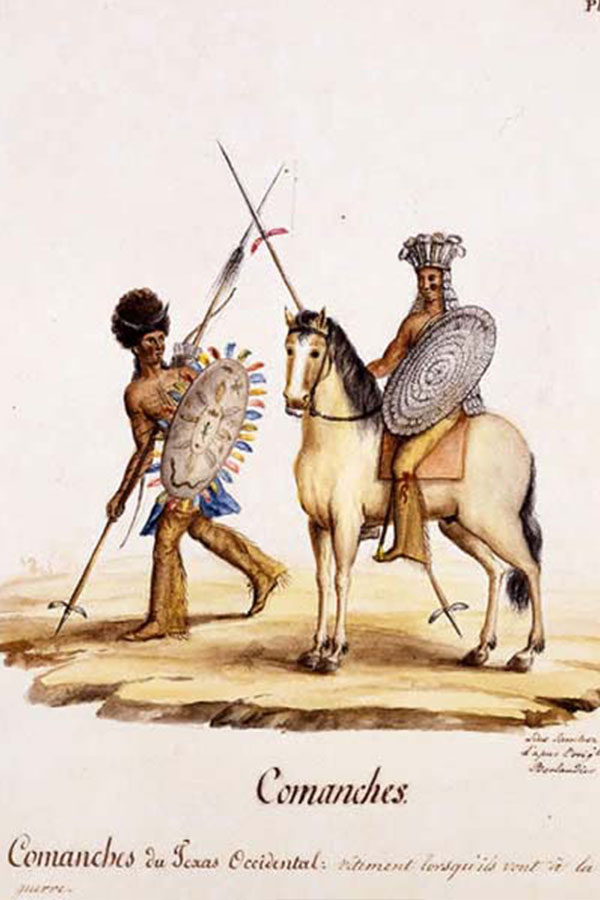New Perspectives: Comanche Culture
Programs
December 8, 2018 10:00am - 12:00pm
The Story of Texas is always changing, discover the best new perspectives through conversations with the state's interesting characters.
Program Details
Join us for a mini-symposium where short talks will reveal fresh insight on historic and current Comanche people. Experts from the fields of history, documentary film and art will provide commentary and share research from their respective disciplines. After the presentations, join the discussion or tour original exhibitions to truly appreciate Comanche contributions to the Texas identity. Program held in conjunction with the exhibition, Comanche Motion: The Art of Eric Tippeconnic
Whether it's a reexamination of the historic tribal range, a study of the Comanche ethos or the development of a native-centric narrative for the big screen, all of the talks at this program will explore how the Comanche have been represented through time. This group of presenters and their work sheds new light and deepens our understanding of the tribe. These new lines of inquiry recognize the crucial role of the Comanche people in telling their own story and allows for a fuller picture of Texas history.
Educator Workshop
Educators are invited to stay for an hour after this program for a workshop (12:00-1:00pm). Museum staff will facilitate a discussion and strategy session for incorporating information from the symposium and exhibition into classroom curriculum. Lunch and CPE certificates will be provided. To register for this workshop, email education@thestoryoftexas.com
Julianna Brannum is a Producer, Director and documentary filmmaker. Her first film, The Creek Runs Red, was selected to air in Fall 2007 on PBS’s national primetime series, Independent Lens. In early 2008, she co-produced a feature-length documentary with Emmy Award-winning producer, Stanley Nelson for PBS’s We Shall Remain – a 5-part series on Native American history. The episode, “Wounded Knee”, chronicled the siege of Wounded Knee, SD in 1973 led by the American Indian Movement. In 2007, Brannum was selected as a Sundance Institute/Ford Foundation Fellow and has been awarded grants from the Sundance Institute’s Native Initiative, National Geographic, ITVS, the Oklahoma Humanities Council, NAPT, and the Sundance Documentary Fund for her documentary LaDonna Harris: Indian 101. In April 2008, she was awarded a fellowship from the Rockefeller Foundation and the Tribeca Film Institute in support of the film. Her most recent project is a series for PBS called "Native America" in which the final episode tells the story of the Comanche and the horse. "Native America" will air nationally on PBS starting October 23, 2018 for 4 weeks. Ms. Brannum is a graduate of the University of Oklahoma and was awarded the 2008 Distinguished Alumni Award for the College of Arts and Sciences. She is a member of the Quahada band of the Comanche Nation of Oklahoma.
Dr. Eric Tippeconnic is a visual artist, lecturer in the history department of California State University - Fullerton and co-curator of Comanche Motion: The Art of Eric Tippeconnic. He is an original American on his father’s side and a first generation American on his mother’s side. Eric’s mother, Kirsten, was born in Copenhagen and left at the age of 18 when she married an American sailor. She grew up in Copenhagen during Nazi Germany’s occupation. Eric’s father, Norman Sr. is a Comanche from Cache, Oklahoma. The Tippeconnic family get their name from Eric’s great grandfather “Tippeconnic” who fought against the United States in the Red River War. Tippeconnic is Comanche for “Rock House.” He was born in Nome Alaska and for much of his early life he lived on numerous Indigenous reservations in California, Arizona and New Mexico. He also had the good fortune to be able to travel quite often to Denmark. Eric credits both his Danish and Comanche cultural heritage for sparking his interest in art and history at a very early age. Consequently, Eric’s artistic vision is representative of his two cultures. As a result of his multicultural experiences, Eric strives to interpret the world through a multitude of lenses both figuratively and literally.
Dr. Joaquin Rivaya-Martínez is an associate professor of history at Texas State University. He obtained a Ph.D. in anthropology at UCLA in 2006 and was a postdoctoral fellow at the SMU Clements Center for Southwest Studies in 2007-2008. He specializes in the history of the indigenous peoples of the US-Mexico Borderlands and the Great Plains during the 18th and 19th centuries. He has conducted extensive archival research in Mexico, Spain, the United States, and France, accessing a massive corpus of non-English-language original sources, some previously untapped. His research incorporates ethnographic, archaeological, linguistic, and environmental evidence, as well as interviews with contemporary consultants. Numerous institutions have funded his research, including the Wenner-Gren Foundation, the American Philosophical Society, the Newberry Library, the Philips Fund for Native American Research, the University of California Institute for Mexico and the US (UC MEXUS), UCLA’s Institute of American Cultures, and Mexico’s CONACyT. Dr. Rivaya-Martínez uses qualitative and quantitative analyses to cement his theories, paying attention to indigenous voices and perspectives from the past and from the present. His scholarship focuses primarily on the Comanches, whose actions influenced decisively the history of a vast expanse on both sides of the Rio Grande. He has conducted his research in close contact with members of the Comanche Nation of Oklahoma. He is the author of numerous scholarly presentations and essays published in the U.S., Mexico, Spain, Canada, France, and Ecuador. His ongoing book manuscript on pre-reservation Comanche practices of captivity, slavery, and incorporation offers a fresh interpretation of the history of the Comanches and the US-Mexico Borderlands.
Support for the Bullock Museum's exhibitions and education programs provided by the Texas State History Museum Foundation.
